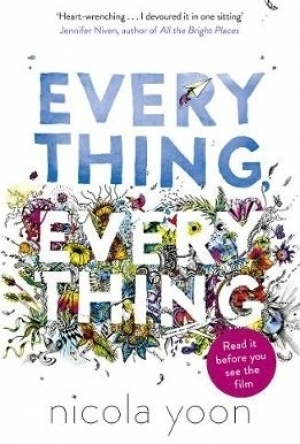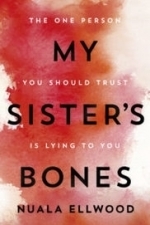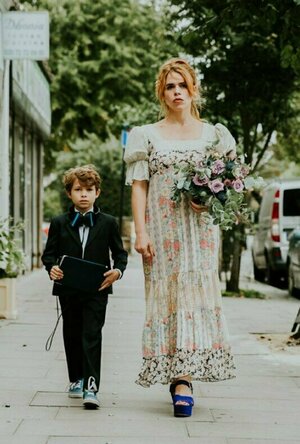Brea Lowther (26 KP) rated Everything, Everything in Books
Feb 5, 2018
The big shock came to me in it's unpredictable predictability. That sounds insane, so let me explain. As soon as you meet Madeline, you learn that she's been locked in her controlled environment most of her life because she has a rare disease called SCID. She gives the basic layout of her diagnosis, life of isolation, and the cute boy next door. She soon begins to question everything.
This is the point of the book, very early on, where I begin to think "Mom probably has Munchausen by Proxy," which is the mental disorder where, for lack of fancy medical knowledge and terms, your make your child or other person close to you sick on purpose to gain sympathy, or because you honestly convince yourself they are sick.
As I read a little more, and Maddy meets, and subsequently falls in love with Olly, I start to realize that I may be jumping to conclusions too soon. After all, this is a young adult novel, not a Gillian Flynn mystery.
When we come to the part of the great escape, Madeline's awakening, her most dangerous adventure, out of the controlled world she knows, I am not surprised to see her get very sick, and have to go to the hospital where she comes close to death.
She hits a period of depression, realizes that she can't see Olly anymore, and breaks his, and her own heart. BUT WAIT! She receives a letter from her doctor in Hawaii who tells her she doesn't have SCID, and her world comes crashing down.
She has to confront her mother, and decide what steps to take to finally start a life that was stolen from her.
I was pleasantly surprised to be tricked out of thinking I guessed the plot, and then thrown for a curve when I was right all along. Aside from that gem, this book did a great job of displaying an outsider's view on domestic violence, and her influencing Olly to have his mom leave. It wasn't your run of the mill teen love story. It showed the bitter betrayal that sometimes happens at the hands of the people who are supposed to love and protect you the most. It showed different mental conditions in different lights. It could've gone into more detail, but just shedding some light in a world where having a sick brain is so taboo is a tremendous feat.
This book was executed simply, and done very well. I am glad I finally read it, and would recommend it to anyone looking for a quick, yet emotional read.
Zuky the BookBum (15 KP) rated The People at Number 9 in Books
Mar 15, 2018
I didnt like the way this was set out, and maybe thats because it was an ARC copy, but this was really choppy and changey, with no indication that a longish time period (a few hours to a whole afternoon) had passed. The writing was fine, I have no faults with that, but it wasnt anything special.
There are four main characters in this book. Sara and Neil and Lou and Gavin. While each of the characters were well developed and in depth, it didnt stop them from being lacklustre and 2D. I couldnt connect with any of them on a personal level. Even though I would get annoyed at certain things Lou said or did, I wasnt getting annoyed on Saras behalf, because I thought Sara was whiny and she got on my nerves too.
One of my issues with this book, other than it being boring as heck, was the pretentious conversations going on, all the time. I know this book was a satire piece on the middle class, I get it, but dont bore us to death with long conversations that are eye rollingly posh and uninteresting. You can create a satire piece without making your readers fall asleep. There is very little description in this book, youll find that 80% of all the writing is speech, so it really did my head in after a while.
Now, this point is completely down to personal preference, but another reason I couldnt get on with this book was because of all the out-of-marriage flirting. It makes me really uncomfortable and squirmy reading that kind of stuff, so, since it was heavily featured in this, I disliked the book even more.
This is going to be a controversial book in terms of opinions, most definitely, and it would probably be a great book to read for a discussion, because youd have lots of differing opinions on the characters, but, heres my two-cents:
Ultimately, this novel is a story about over indulged middle class suburban families doing things a little bit risky like sex in a tent or smoking weed, and worrying about things only unrealistic well-off people could worry about, like home-schooling and arts and crafts. Not worth the time it takes to read.
<i>Thanks to Netgalley and HQ for giving me the opportunity to read this in exchange for an honest review.</i>
Zuky the BookBum (15 KP) rated My Sister's Bones in Books
Mar 15, 2018
NOW AVAILABLE IN THE UK!
<b>Trigger warnings are noted in the first paragraph.</b>
<b><i>Were all of us, every day, just a hairbreadth away from evil. If Ive learnt anything from fifteen years of reporting, its that. But I couldnt expect these people to understand.</b></i>
This is a really heavy read as it deals with some really dark and depressing subjects, <b>such as the war and refugees in Syria, domestic & child abuse, rape, death, mental illness, alcoholism and miscarriages.</b> Dont read this if youre having a low period in your life because this is not going to make you feel any better, throughout its a rather distressing and upsetting story.
Each character in this novel was well developed, no matter how small a part they played in the plot. Ellwood has done a fantastic job with her research into PTSD as Kates fears and anxieties seem so real to the reader. Though Ive never experienced anything even close to PTSD, I can really imagine how terrifying and disturbing it would be, from reading this book. Its definitely the best and most harrowing description of the condition Ive ever read in a fiction novel.
This was a really well presented novel and Im amazed that its a debut! It was excellently written and thought out. My only issue being that sometimes, the timings in this book felt a little off. When Kate and Paul were together, one minute they'd be serving dinner and the next, after a small 5 lined conversation, it would be midnight and time for Paul to leave and Kate to get into bed. It seemed like large chunks of the day would just disappear.
Maybe I shouldnt have read some other peoples reviews on this beforehand, but because I was expecting all these super duper amazing twists, I kind of didnt feel that they were super duper amazing. I also found some of them to be a little far fetched and silly, rather than surprising.
I can definitely see why this has gained so many 5 star ratings, but its all down to personal preference at the end of the day, and this one was just a little too dark for my liking. That's not to say I didn't like this...I enjoyed this a lot, hence the 4 stars. I found myself not wanting to put it down, even when my eyes were telling me it was definitely time for sleep. It was certainly a thrilling and page turning read, but I dont know if I could recommend this to anyone because of all the dark subject matters. It seems like the sort of book some people are going to love for its dark realism and others are going to hate that and find it too distressing to read.
Thanks to Netgalley and Penguin Books UK for giving me the opportunity to read this in exchange for an honest review.

ABC Magnetic Land: Learn Alphabet,Shapes & Letters
Education and Games
App
***** A title from our extremely successful series: the last three titles (ANIMAL PRESCHOOL SHAPE...

Security of Title and Government-Investor Relationship
Book
Dr Lionel Etan-Adollo has set the benchmark for evaluation, comparison and investigation for many...
Lucy Buglass (45 KP) rated Rare Beasts (2019) in Movies
Oct 14, 2019
Rare Beasts follows Mandy, a career-driven single mother (Billie Piper) and her turbulent relationship with Pete (Leo Bill). Possibly the most frustrating thing about this film as it’s unclear why the two of them even ended up together at all.
It’s not uncommon for people to choose poorly when they’re dating, and end up in a relationship that doesn’t work, but Rare Beasts offers no reason for the two to even end up together in the first place. Mandy’s a single mother, she’s wild, she wears bold clothing, and Pete is a traditionalist who is, frankly, a misogynist with anger issues.
Interestingly, the film’s synopsis describes Pete as ‘charming’, and I’m unable to see that quality in him, nor is it ever shown from Mandy’s point of view. She never once looks at Pete lovingly, or seems charmed by him.
The lack of context or any indication as to what drove them to be together is a problem for me. Even if we saw one tiny nice moment between them it would make sense, but throughout the film they’re consistently awful to each other with no redeeming features.
Combined with a narrative that is all over the place and dialogue that feels very unnatural, it comes across as jarring most of the time. I have no issue with unconventional film styles, but I found it very hard to follow what was going on at various points.
It seems Rare Beasts is confused about what tone its actually going for, switching between whimsical musical style scenes (minus the music or singing) and gritty realism in a matter of seconds.
I appreciated the efforts to raise awareness of social issues such as domestic abuse, gender inequalities and the struggles of bringing up a child as a single parent, but these messages are squashed by a visual style that is rather overwhelming.
There is also a sub-plot involving Mandy’s parents (Kerry Fox and David Thewlis), who have separated but appear to have a complicated relationship. This is never fully explained either so it’s hard to connect with them, especially when Mandy’s mother falls ill.
This attempt to tug at our heartstrings falls flat, which is disappointing as it had the potential to bring some real, raw emotion to Rare Beasts. Sadly it’s as disjoined and confusing as Mandy and Pete’s relationship.
It’s clear those involved in the film gave it their all, and I can’t fault the quality of the actors even though some of the lines didn’t work and felt too far removed from natural conversation to be taken seriously. At least they tried.
Billie Piper has talent, there’s no doubt about it, but she hasn’t quite made it work in this very daring debut behind the camera. If Rare Beasts was attempting to be relatable and resonate with audiences, it failed to do that with me.

Moja mBanka Raiffeisen
Finance
App
Moja mBanka Raiffeisen – uvek uz Vas 24h/7! Moja mBanka Vam omogućava da brzo i jednostavno,...

Pekao24 na tablety
Finance
App
Logujesz się i od razu wiesz, ile masz środków na koncie, ile wydajesz i na co. Przegląd Twoich...

Bank Millennium
Finance and Productivity
App
Aplikacja mobilna Banku Millennium łatwo dopasowuje się do indywidualnych potrzeb użytkowników....




